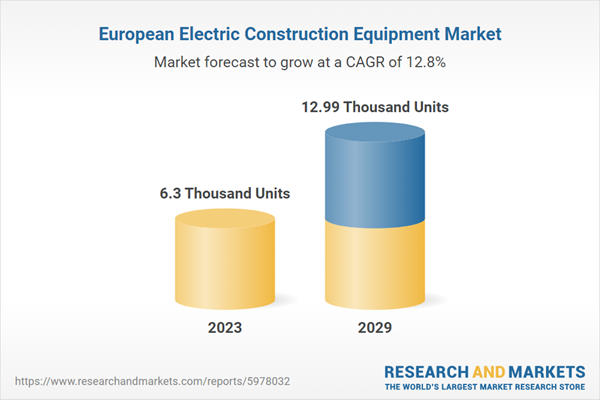Dublin, June 26, 2024 (GLOBE NEWSWIRE) — The “Europe Electric Construction Equipment Market – Industry Outlook & Forecast 2024-2029” report has been added to ResearchAndMarkets.com’s offering.
The Europe Electric Construction Equipment Market totaled 6.30 Thousand Units in 2023, and is expected to reach 12.99 Thousand Units by 2029, rising at a CAGR of 12.81%
The Europe electric construction equipment market shifted focus to sustainability, prompting comprehensive analysis beyond exhaust emissions. Key concerns now include fuels, lubricants, maintenance facilities, mobility, and overall equipment operation for a greener fleet initiative. Leading vendors like Volvo, Komatsu, and Hyundai have spearheaded sustainability integration, emphasizing eco-friendly construction equipment in asset management practices. Large OEMs adopt advanced telematics and machine data analytics to customize solutions for end customers.

The Europe electric construction equipment market exhibits varied growth rates across different countries. Leading nations in the market, including the U.K., Germany, France, Norway, and Sweden, show strong acceptance and efforts to transition towards fossil-free construction sites, while other EU countries lag. Furthermore, Germany holds the most significant share of the Europe electric construction equipment market, accounting for over USD 261 million in 2023.
Overall, the Europe electric construction equipment market demonstrates a concerted push towards sustainable construction practices, emphasizing decarbonization, energy efficiency, and adoption of innovative technology. Key insights regarding electric construction machinery adoption and charging infrastructure are:
MARKET TRENDS & DRIVERS
Demand for Sustainable Projects Across the Region
The escalating demand for sustainable and net-zero buildings is driving a parallel surge in the preference for electric construction equipment. This shift is pivotal in significantly reducing overall emissions during construction activities and supports the growth of the Europe electric construction equipment market. The European Environment Agency conducted a comprehensive study revealing that construction activities contribute approximately 36% of the emissions of carbon dioxide in the European Union.
The adoption of electric construction machinery emerges as a transformative solution with the potential to diminish this environmental impact substantially. As of 2020, it was estimated that electric construction machinery had contributed by saving around 2 million tonnes of carbon dioxide emissions, underscoring the pressing need for eco-friendly alternatives. Further, as the number of green buildings continues to rise, there is a corresponding surge in the demand for electric construction equipment. This is particularly evident due to the negligible emissions associated with electric equipment compared to their traditional counterparts powered by fossil fuels.
Impact of Fossil-Free Construction Sites
European Union nations endorse fossil-free construction sites, aligning with the European Commission’s sustainability initiatives. Key cities such as Helsinki, Oslo, Copenhagen, Vantaa, and Barcelona are committed to targets mandating fossil-free construction machinery in public projects, aiming for emission reduction and widespread adoption of zero-emission construction equipment by 2025 and 2030. This joint commitment reflects a collective effort, incorporating collaborative initiatives, knowledge-sharing platforms, and a unified drive toward a greener construction industry in the EU.
Major cities’ recent declaration of intent, part of the European Commission’s collaborative initiative, underscores a significant step towards sustainability, emphasizing the adoption of zero-emission construction equipment. Furthermore, the commitment of major European cities and the growing demand for fossil-free construction sites serve as a strong growth catalyst for the Europe electric construction equipment market.
SEGMENTATION INSIGHTS
INSIGHTS BY EQUIPMENT
The Europe electric construction equipment market by equipment is segmented into excavators, wheel loaders, skid steer loaders, backhoe loaders, dump trucks, telehandlers, aerial platforms, and others. Among these, excavators hold the largest share within the equipment segment, with substantial volume and value recorded in 2023. The transition towards electric construction equipment is progressing significantly, mainly focusing on compact ranges.
Forecasts indicate that by 2030, manufacturers will introduce electric versions of larger equipment such as cranes. Present market conditions reveal a higher demand for medium and compact equipment than larger counterparts. This trend is primarily attributed to challenges associated with developing batteries suitable for large equipment and establishing adequate charging infrastructure on construction sites. As the industry continues to evolve, addressing these constraints will be crucial for further market expansion and adoption of electric construction equipment across all segments.
INSIGHTS BY BATTERY CAPACITY
The< 50Kwh battery capacity segment holds the most significant European electric construction equipment market share in 2023. The sales of electric construction equipment with battery capacities below 50 kWh are higher for several reasons.
INSIGHTS BY BATTERY CHEMISTRY
The Europe electric construction equipment market by batter chemistry includes Nickel Manganese Cobalt (NMC), Lithium Iron Phosphate (LFP), and other batteries. NMC batteries hold a major share in this segment due to their higher energy density and lower price than other alternatives, making them a more favored power source for construction equipment manufacturers. Further, innovation in battery technology is rapidly advancing for electric vehicles (EVs) and off-highway vehicles, with companies offering diverse solutions to boost performance. Lithium iron phosphate (LFP) batteries are gaining traction in the EV industry due to their affordability, safety, and longevity, outperforming nickel manganese cobalt (NMC) batteries.
Although commercialization is ongoing, solid-state batteries offer higher energy density and safety advantages. Sodium-ion batteries emerge as a lithium-free option with potential cost and charging benefits. Furthermore, improvements in solid-state battery manufacturing, particularly in dry room technology, could expedite their adoption. Despite varied alternatives, the industry aims for efficient, cost-effective, and eco-friendly energy storage solutions, vital for future transportation and construction advancements. Tracking battery technology developments remains pivotal.
INSIGHTS BY END USER
The Europe electric construction equipment market by end-user is segmented into construction, warehouse and logistics, mining, and others. The construction industry includes maintenance, renovation of public infrastructure, housing projects, and non-residential construction. Increased demand for infrastructure projects increases the demand for construction segments with a major market share.
The mining industry involves mining coal, natural minerals, and others. Equipment like excavators, wheeled loaders, skid steer loaders, motor graders, bulldozers can be used extensively in the mining sector. With the continuous expansion of the warehouse and logistic sector across Europe, demand for material handling equipment is increasing.
GEOGRAPHICAL ANALYSIS
- Finland stands out with its focus on energy efficiency, clean electricity production, and commitment to battery technology.
- ABB E-mobility’s investment in Italy further boosts electric vehicle infrastructure.
- Cities like Helsinki, Vienna, and Budapest are implementing green initiatives, while Dutch companies like TSG Netherlands and MRA-Electric are advancing electric vehicle infrastructure.
- Sweden showcases leadership in mobile energy storage and fossil-free steel construction.
- Norway leads in mandating zero-emission machinery in construction projects, supported by Enova’s subsidy programs.
- France and Germany are at the forefront of the electric revolution in construction, driven by Volvo C.E., Mecalac, and initiatives like RE2020 in France and Energiewende in Germany.
- London and Oslo set ambitious targets for emission-free construction, while UK grants support electrification efforts – danfoss pioneers energy-efficient technologies, receiving funding for electrification projects in the UK.
- Enova in Norway initiates two programs targeting emission reduction in construction, spanning two years. They promote emission-free construction equipment and mobile charging stations, offering subsidies covering up to 40% of additional costs. They capped 5 million Norwegian kroner for electric machinery and 2 million for charging stations with buffer batteries.
- TSG Netherlands introduces the WattHub, a specialized charging plaza for electric trucks and off-road vehicles in Guelders, Netherlands. It employs Kempower hardware with a 3.6 MW capacity, powered by renewables, featuring six 600 kW Power Units and 36 Satellites. Kempower’s software dynamically manages charging processes.
KEY QUESTIONS ANSWERED
- How big is the Europe electric construction equipment market?
- Which region dominates the Europe electric construction equipment market share?
- What is the growth rate of the Europe electric construction equipment market?
- Who are the key players in the Europe electric construction equipment market?
- What are the significant Europe electric construction equipment market trends?
Key Attributes:
| Report Attribute | Details |
| No. of Pages | 245 |
| Forecast Period | 2023 – 2029 |
| Estimated Market Value in 2023 | 6.3 Thousand Units |
| Forecasted Market Value by 2029 | 12.99 Thousand Units |
| Compound Annual Growth Rate | 12.8% |
| Regions Covered | Europe |
Market Opportunities & Trends
- European Regulatory Initiatives on the Adoption of Low-Emission Technologies
- Demand for Sustainable Projects Across the Region
- Hybrid Technologies Driving Demand for Electric Construction Equipment
- Future Evolution of Electric Construction Equipment
- Sustainable Power Sources
- Telematics Technology
- Process Automation
Market Growth Enablers
- Fossil-Free Construction Sites
- Battery Technology Prioritization in European Countries
- Impact of Low Economic Zones
Market Restraints
- Lack of Charging Infrastructure on Construction Sites
- High Cost of Ownership of Electric Construction Equipment
- Aging Workforce, Building Materials & Skilled Labor Shortage
- Lower Energy Density of Batteries
- Lack of Sufficient Availability of Raw Materials
Key Company Profiles
- Volvo
- Komatsu
- Hitachi
- Wacker Neuson
- Liebherr
- Caterpillar
- Kobelco
- Kubota
- HD Hyundai Construction Equipment
- Bobcat
- JCB
Other Prominent Vendors
- Kramer
- John Deere
- SUNCAR
- XCMG
- Manitou
- SANY
- MECALAC
- Limach
- Schaffer
- Yanmar
Component Suppliers
- North Volt
- ABB
- Eaton
- Epiroc
- Instagrid
- Urban Mobility Systems
- Ecovolta
For more information about this report visit https://www.researchandmarkets.com/r/sxzx5d
About ResearchAndMarkets.com
ResearchAndMarkets.com is the world’s leading source for international market research reports and market data. We provide you with the latest data on international and regional markets, key industries, the top companies, new products and the latest trends.













